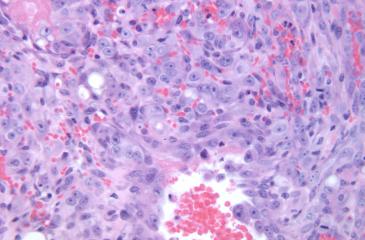Uncovering the origins of a deadly canine cancer
Researchers from the University of Minnesota College of Veterinary Medicine (CVM) and the Masonic Cancer Center (MCC) have identified the likely cell of origin for canine hemangiosarcoma—one of the deadliest forms of cancer in dogs, with a nearly 100 percent mortality rate within two years of diagnosis. These findings may pave the way for new therapies for dogs diagnosed with the devastating disease—and for people diagnosed with angiosarcoma, a similar cancer that occurs in humans.
Scientists have long thought that hemangiosarcomas (and angiosarcomas) arise from endothelial cells, or the cells that line the inside of the blood vessels. This understanding was mostly based on what could be deduced by looking at tumors under a microscope. But it was inconsistent with what doctors saw when trying to treat the tumors. Hemangiosarcomas show strong resistance to chemotherapy and other targeted therapies designed to kill endothelial cells or arrest formation of new blood vessels—suggesting that those therapies are aimed at the wrong targets.
Previously, the research team published data suggesting that the canine tumors developed from blood-vessel-forming cells, rather than the blood vessel cells themselves. “This was more than a semantic distinction, because in our hypothesis, the tumor cells could give rise to different components of the blood vessel, and maybe also to a type of white blood cells, and not just the endothelial cells,” noted Jaime Modiano, director of the Animal Cancer Care and Research Program of the CVM and MCC, who led the research. Subsequent research from other groups suggested that the same may be true for humans.Tumor cells in the blood vessel lining of a canine patient with hemangiosarcoma. The light purple cells are cancerous cells forming the tumor mass. The pink cells are red blood cells. The dark purple cells are white blood cells, which signal inflammation.

In the new study, the researchers found that the cancerous cells both intersperse themselves among normal blood vessel cells, as expected, and they also occur in densely packed areas that form the tumor mass.
“More interestingly, we have known for a long time that these tumors tend to have a lot of inflammation,” described Modiano. The assumption was that the inflammation was the body's response to the tumor. “But here we show that the malignant cells actually behave like cells that support blood origin and blood development in normal organisms. This suggests that at least part of the inflammation might be because the tumor is providing a good home for blood cell differentiation.” In other words, new blood cells are able to form within the tumor.
This is important because if the tumors arise from the same cells that promote the growth of new blood and blood vessels, it also might explain why these tumors are so resistant to chemotherapy and radiation. Specifically, the normal cells that support blood formation in the bone marrow are essential for the success of bone marrow transplants, because they are very resistant to chemotherapy and radiation. So, those treatments can eliminate tumors from the bone marrow and make space for the transplant, without killing off the cells that are necessary to create a hospitable environment for the new, transplanted bone marrow to survive and thrive.
Because hemangiosarcomas arise from these cells that are biologically equipped to resist common treatments, combatting them requires new approaches. “With this knowledge, we can now work to develop more specific therapies that could target these cells for destruction and/or mitigate their capacity to form tumors, creating new hope that we can improve outcomes for dog and human patients with these life-threatening cancers,” Modiano said.
Another silver lining related to their discoveries: given their newly-understood nature, these cells could actually become a tool for creating blood products in the lab that could be used for blood transfusions, transplants, and other therapies. While that vision is currently a long way from reality, it shows how scientific solutions often come from unexpected places.
Read the full study in Cancer Research Communications.
This article was first published by the College of Veterinary Medicine.
